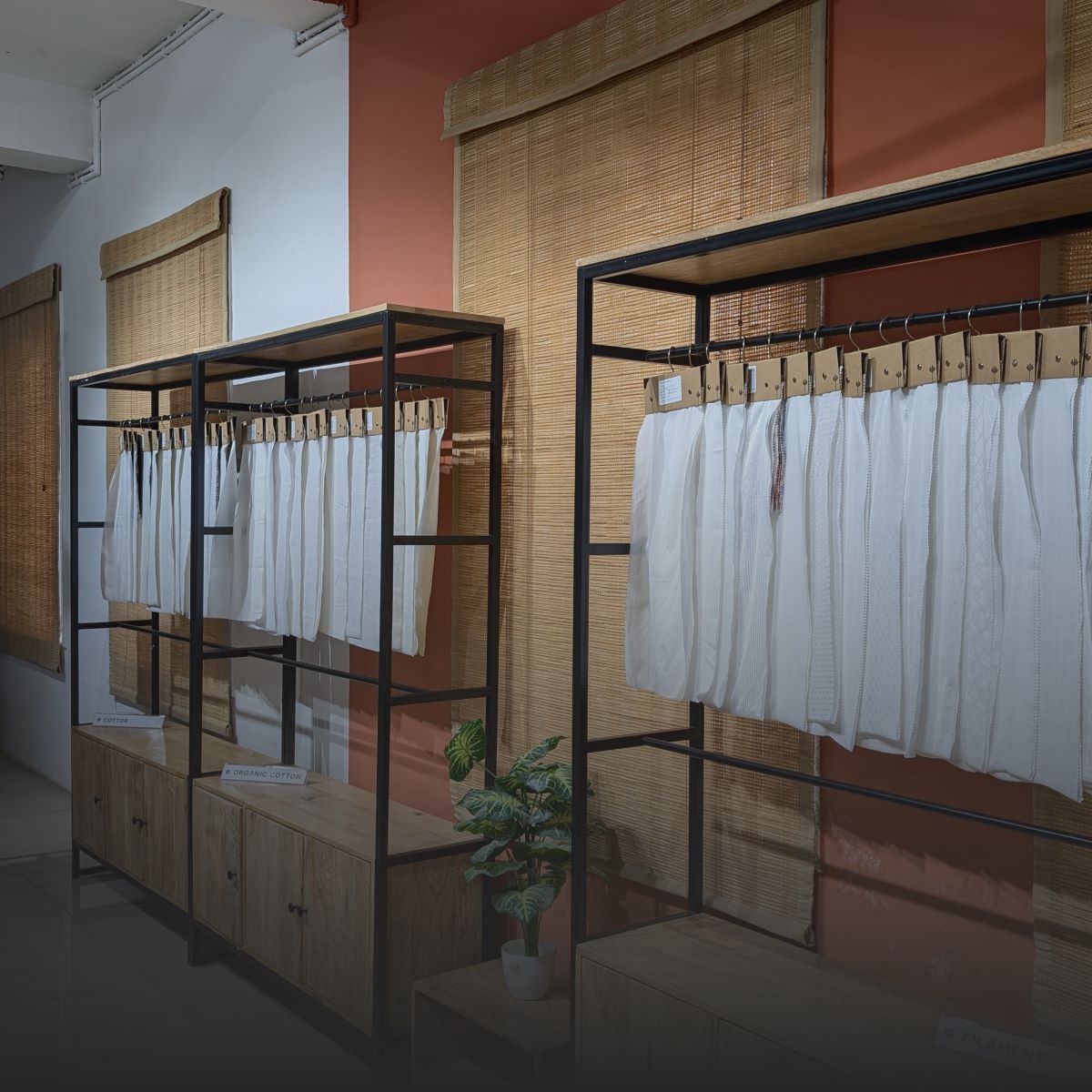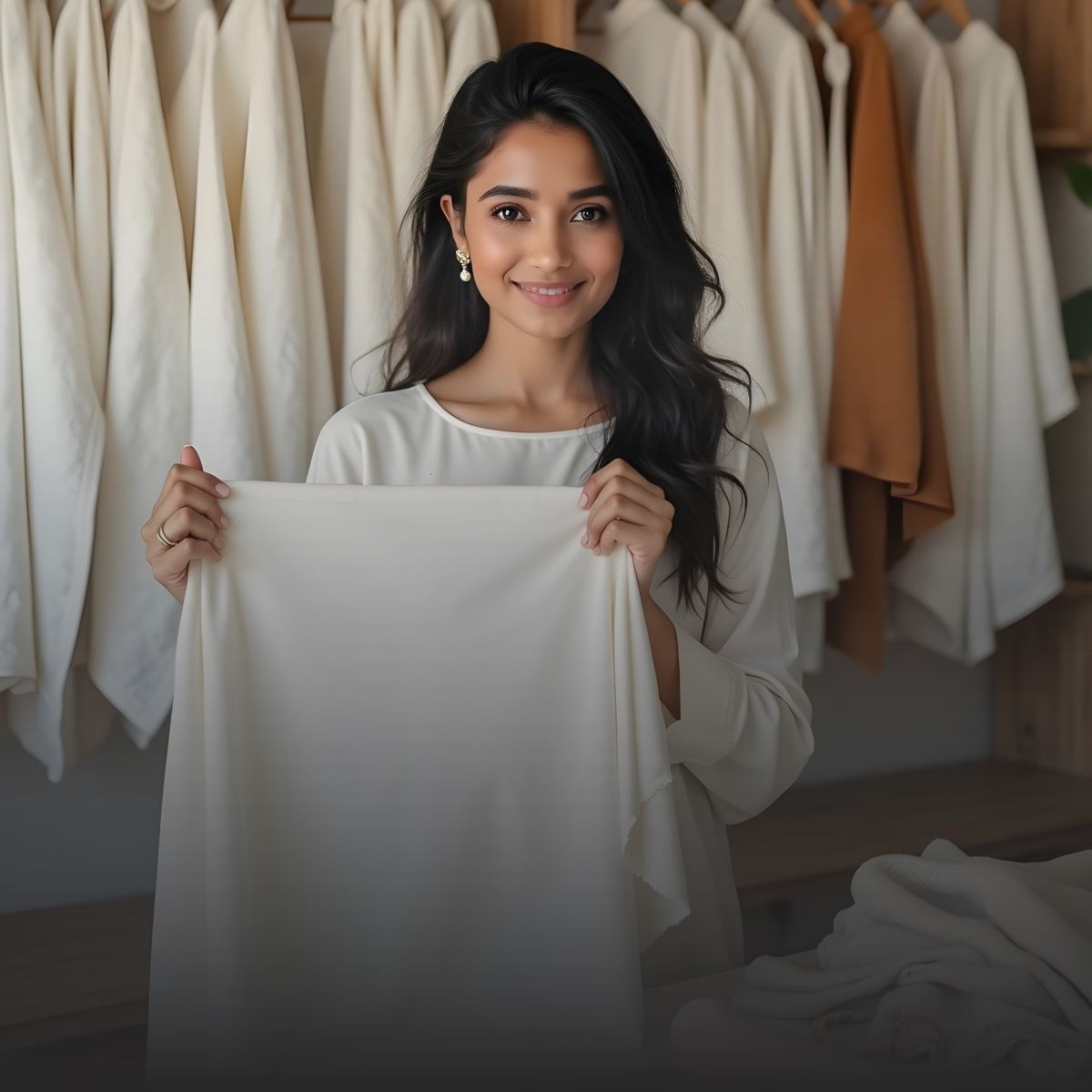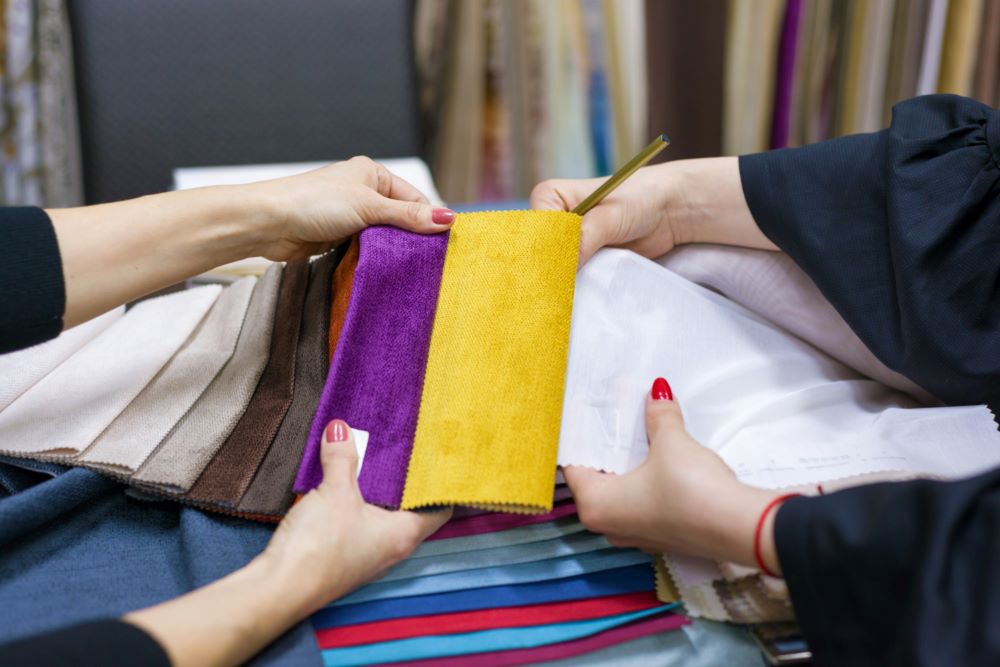To make your fashion dreams come true, you need to find the right fabric. Minimum order quantities (MOQ) set by fabric suppliers can be very hard for a lot of small names and new businesses. When MOQs are too high, they can limit your creativity, make your budget tight, and slow you down. Many trustworthy textile suppliers, such as Fabriclore, offer low minimum order quantities in sourcing, making it easier for you to get started.
Many are facing the same MOQ challenges, and there's a way to overcome them together. Unlock the potential to conquer these challenges and discover premium fabrics while keeping your resources intact. Discover how to easily tackle MOQ challenges using this comprehensive guide that covers all the essentials you need to succeed.
You Can Also Read This For More Related Information : Fabriclore introduces a range of Mill-dyed Fabrics at low MOQs.
What Are MOQ’s In Fabric Sourcing?

Minimum Order Quantity is what MOQ stands for. It's the smallest amount of fabric that a seller wants you to buy all at once. In the world of textile manufacturing, minimum order quantities (MOQs) are essential to keep costs low for the supplier during production, logistics, and material buying.
How MOQs Work in Fabric Supply Chains
For fabric mills and wholesalers, every production run comes with set costs like:
- Setting up and calibrating the machine
- Getting ready for printing and dying
- The cost of labour to weave or knit
- Checking for quality and packing
MOQs make sure that these costs are covered by an order that is big enough. However, it can be hard for small clothing brands to meet high MOQs, especially when they don't have much money to spend on production or are trying out new lines.
Why Are High MOQ’s A Problem For Small Apparel Brands?

High MOQs can make things complicated for new names in several ways, such as:
1. Limited Financial Resources
Small brands often don't have a lot of money, so it's hard for them to commit to buying hundreds of meters of fabric all at once.
2. Risk of Overstocking
These things can happen if you order more fabric than you need:
- Excess inventory
- Additional storage costs
- Difficulty moving unsold designs
3. Reduced Design Freedom
Brands may have to give fewer styles, colours, or sizes when MOQs are high, which can stop innovation and creativity.
4. Cash Flow Disruption
Putting a lot of money into the fabric at the beginning can tie up working capital, hurting other vital areas like marketing, hiring, or logistics.
6 Proven Strategies To Overcome MOQ Challenges In Fabric Sourcing

Instead of letting high MOQs stop the growth of your brand, try these tried-and-true methods:
1. Partner with Vendors That Specialize in Low MOQs
Find those who work with small and medium-sized brands.
Some vendors, like Fabriclore, offer fully customised fabrics with low minimum order quantities. These are great for small brands, new designers, and D2C (direct-to-consumer) labels.
Where to find such suppliers:
- Trade shows in the industry, like Texworld and Premiere Vision
- Online stores that focus on buying from safe or local sources
- Reach out directly to carefully chosen sites like Fabriclore
Pro Tip: Get to know your source. When you buy from them again, the MOQ terms can get even better over time.
2. Choose From Stock Fabric Collections
Stock fabrics are already made and easy to find, so they don't need a new production cycle. Picking stock materials has many benefits, including:
- No minimums or very low minimums
- Faster turnaround times
- Reduced costs since fabrics are produced at scale
Fabriclore's stock service collection has a vast selection of Mill Dyed and RFD fabrics with different weaves, textures, and combinations, which makes it an excellent place for small brands to start.
Start sourcing effortlessly with Fabriclore’s ready-to-ship collection—perfect for building your brand with ease and variety.
3. Collaborate with Other Brands or Manufacturers
You can meet your MOQ without worrying about your finances if you pool your orders with those of other small brands.
Methods of Collaboration:
- Shared Bulk Orders: When several brands make one order, the fabric is split among them based on their needs.
- Co-production: Work with factories that let small brands group their orders together.
- Joint Sourcing: Communities are online communities or groups where brands collaborate to buy things.
Collaboration improves things for everyone, so you can get high-quality fabrics without spending much money.
4. Negotiate More Flexible Terms With Suppliers
Negotiation is not just possible—it's expected in fabric sourcing.
You can talk about the following:
- Lower MOQ for First-Time Orders: Many suppliers are ready for production test runs.
- Mixed MOQ Orders: Place an order for a mixed MOQ that includes different colours, prints, or types of cloth.
- Installment Payments: To make your cash flow easier, split your payments into several amounts.
Tip: Be honest about how much traffic you could get in the future. Suppliers may offer better deals if they see a chance for a long-term relationship.
5. Explore Digital Fabric Sourcing Platforms
Technology has changed how small brands get their supplies. Platforms like Fabriclore wholesale fabric manufacturers USA let you:
- Making custom fabrics with low minimum order quantities
- Clear pricing models
- Access to businesses that are ethical and environmentally friendly in the USA, India and beyond
- Order tracking that works well and changes in real-time
These sites let small brands get high-quality fabrics that are only available to large manufacturers.
6. Prioritize Sustainable and Ethical Fabrics
Smaller, more customized production runs are common for sustainable fabrics, which is excellent for low MOQ sourcing needs. Some popular eco-friendly materials are:
- Tencel™: Soft, durable, biodegradable
- Liva Eco™: Made from certified renewable wood sources
- Ecovero™: Sustainable viscose with a low environmental impact
- Organic Cotton and Linen: Grown without harmful pesticides
Many "sustainable fabric suppliers" encourage buying in smaller amounts to reduce waste, which is good for the environment and business.
Why Do Suppliers Use Minimum Order Quantity (MOQ)?

Most of the time, suppliers use MOQs to cover set production costs, keep things running smoothly, and protect their profit margins. Costs are associated with getting raw materials, labour, setting up machines, and moving the cloth around. MOQs are essential for the supplier's financial security because smaller orders might not bring enough money to cover these costs.
How Does Minimum Order Quantity (MOQ) Impact Inventory?

When MOQs are high, brands may have to buy more fabric than they need, which can cause them to have too much inventory. This can lead to a number of problems, such as:
- Increased storage costs
- Risk of fabric wastage
- Cash flow constraints
- Limited flexibility for future designs
On the other hand, MOQs help sellers avoid the risks and costs of keeping stock that hasn't been sold, which makes the production cycle more predictable.
Benefits Of Minimum Order Quantity (Moq)

MOQs can be very helpful for both buyers and sellers if they are managed correctly:
Benefits for Suppliers
- Improved Cash Flow: Minimum order quantities (MOQs) ensure sellers get paid in amounts significant enough to keep their cash flow healthy.
- Lower Inventory Costs: Instead of making big batches before they know who will buy them, suppliers can wait to make them until they have enough successful orders. This lowers the costs of storage and warehouses.
- Better Profit Margins: With MOQs, producers can only make things when it makes financial sense to protect their profit margins.
Benefits for Buyers
- Economies of Scale (Bulk Savings): When you buy more, the price per unit usually decreases, making the buyer more profitable overall, even though it costs more to store.
- Improved Supplier Relationships: If buyers follow MOQs and negotiate well, they can build long-term relationships with sellers. This could lead to better payment terms, faster orders, and access to special collections of fabrics.
What Influences Minimum Order Quantity (MOQ)?

There are plenty of things that affect how sellers set MOQs, such as:
- Production Costs: When production costs are high, MOQs also need to be higher.
- Material Availability: Minimums are usually higher for materials that are hard to find or made to order.
- Supplier Capacity: MOQs are usually higher from bigger providers whose processes are automated.
- Level of Customization: For custom colours, prints, or weaves, you usually need to place a larger order.
- Market Demand: Fabrics that are in high demand may have lower MOQs because they are sold so often.
How to Calculate Minimum Order Quantity (MOQ)

MOQs are usually set by sellers, but buyers can also figure out the best MOQ. This is the basic formula:
- Forecasted Demand: How much fabric you'll need in a certain amount of time.
- Storage Capacity: How much room you have for your goods.
-
Financial Resources: The amount of money you have to spend on fabric.
Keeping these things in check will help you negotiate more wisely.
Tip: Modern inventory management solutions might increase minimum order numbers. Tracking real-time stock, anticipating demand, automating reorders, and analyzing purchase habits helps prevent overstocking and lower storage costs.
Three Steps to Implement a Minimum Order Quantity (MOQ)

Here's an easy plan for businesses that want to set MOQs or deal with them:
- Analyze Demand Trends: Know how often your products sell out and what your customers want.
- Smart Negotiation: Talk to sellers about flexible MOQs based on what you need.
- Align Inventory Strategy: To avoid having too much inventory, ensure the dates for buying things and the plans for making things are in sync.
The Advantages Of Successfully Managing MOQ Challenges

Getting rid of MOQ problems in the right way opens up a lot of benefits for brands that are growing:
-
More options for expanding product lines: There is a chance for brands to add to their lines without having to worry about buying too much.
-
Better management of inventory: Effective sourcing methods cut down on wasted goods and storage costs significantly.
-
Better cash flow: Less money spent at the start means more cash for essential business tasks like promotion, hiring staff, or growing.
-
Better partnerships with suppliers: Negotiations with open and polite suppliers lead to long-lasting relationships and often better terms and faster response times.
- Resolve to Use Sustainable Methods: You can leave much less of an impact on the environment and make sure your brand fits the values of eco-conscious customers by choosing smaller, brighter production runs.
Final Verdict: Navigating MOQ Challenges in Fabric Sourcing

Crafting smarter, more resilient supply chains that elevate your brand is key to overcoming fabric sourcing minimum order amounts. Partnering with flexible suppliers, investigating stock textiles, negotiating strategically, partnering with other businesses, and using digital sourcing platforms can turn MOQ constraints into growth possibilities.
Small brands may unleash their creativity, cut inventory expenses, improve supplier partnerships, and grow sustainably by managing MOQs. Starting or developing a fashion label? Mastering MOQ methods lets you express your creativity while keeping quality and finances.
Minimum Order Quantity FAQs
Q1. Can MOQ’s Be Negotiated?
Ans: Many suppliers are open to negotiations, especially if you propose alternative solutions like bundled styles or long-term contracts.
Q2. What Is A Typical Moq For Fabric Suppliers?
Ans: It varies widely—some may require as little as 50 meters, while others may need 500 meters or more, depending on the fabric type and customization.
Q3. How Do I Find Low-Moq Fabric Suppliers?
Ans: Look for sourcing platforms like Fabriclore, which specialises in custom, low-MOQ fabric solutions for small to mid-sized brands.
Q4. Is It Better To Buy Stock Fabric To Avoid MOQ Challenges?
Ans: Stock fabrics often have no MOQ or a very low minimum, making them ideal for smaller collections and prototyping.
Q5. What Are The Different Types Of Moqs In Fabric Sourcing?
Ans: There are different types of MOQs, depending on the supplier and product:
- Piece MOQ: A minimum number of fabric pieces per order.
- Meter/Yard MOQ: A minimum number of meters or yards is required.
- Order Value MOQ: A minimum monetary amount must be met, regardless of the product quantity.
- Style/Color MOQ: Some suppliers may require MOQs per style or colour variant, affecting customization options.
Understanding the type of MOQ helps buyers better negotiate and plan their purchases.
Ready to overcome MOQ challenges and bring your creative ideas to life?
Visit Fabriclore today and explore a world of custom fabrics with low minimums, tailored for fast-growing fashion brands.
We also happen to be a magnet for suggestions, and would love to catch yours….throw us yours on hello@fabriclore.com





